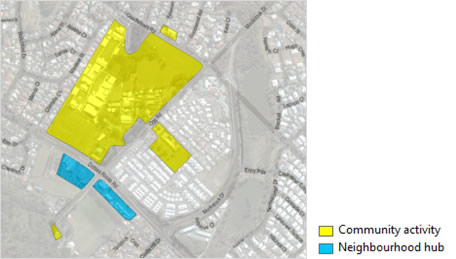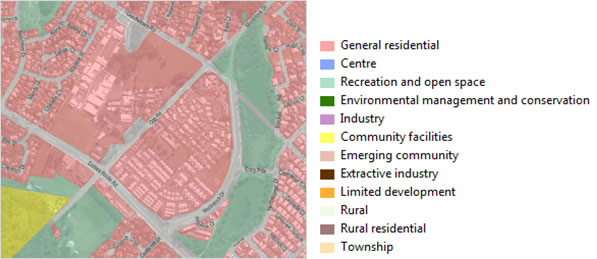MBRC Planning Scheme - Community activities and neighbourhood hubs
The planning scheme recognises the limited impact small scale centres and community activities have on the larger centres. It also recognises their importance in terms of forming the heart of communities and walkable neighbourhoods. Residential places should expect to see retail, commercial and community uses that meet the convenience, day-to-day needs of the surrounding community and provide informal and safe meeting places for residents.
The planning scheme makes provision for retail, commercial and community uses to occur in some zones in the form of a corner store, mixed use building or a neighbourhood hub. For further information on corner stores and mixed use buildings refer to parts 5, 6 and 7 for the relevant zone or precinct.
Community activities may include; child care centre, club, community care centre, community use, educational establishment, emergency services, health care services and place of worship. Community activities may establish within neighbourhood hubs.
A neighbourhood hub is a cluster of non-residential uses (retail, commercial and community uses) that establish and form part of residential neighbourhoods. They are a conveniently located public place that is recognised and valued in the local community as a gathering place for people, and an access point for a wide range of community activities, programs, services and events.
Clusters of existing retail and commercial uses not of a size and scale to be considered a local centre (e.g. those with a full-line supermarket or a fully functioning main street) have been zoned according to the surrounding zone and precinct e.g. General residential zone – Next generation neighbourhood precinct. This makes it easier for struggling activities or empty tenancies to convert back to residential uses.
Existing neighbourhood hubs and community activities in the General residential zone, Industry zone and Rural residential zone have been mapped on Overlay map - Community activities and neighbourhood hubs. This allows existing neighbourhood hubs and community activities to evolve through tenancy changes and ensure the establishment of new neighbourhood hubs does not result in catchment overlap with existing neighbourhood hubs. Provisions to guide the type, size, location and design of non-residential uses and the formation of neighbourhood hubs is contained in the relevant precinct of the zone code in which they are located (e.g. General residential zone code - Next generation neighbourhood precinct).
Example overlay map - Community activities and neighbourhood hubs
Below is an example of the overlay map and the zone map for this same location.


View Overlay map - Community activities and neighbourhood hubs(PDF, 33MB)
Do I need Council approval?
The following table summarises the category of development and assessment (type of application needed, if any) and relevant assessment benchmarks (requirements) for Retail and commercial activities and Community activities.
Accepted development subject to requirements does not require development approval from Council provided it complies with the relevant assessment benchmarks outlined in the planning scheme. If the proposal does not comply with the relevant requirements, a development application must be lodged with Council for approval. Assessable development (Code assessment and impact assessment) requires approval from Council.
Retail and commercial activities
| Land use |
Zone / Precinct |
Categories of development and assessment |
Assessment benchmarks |
- Food and drink outlet
- Hardware and trade supplies
- Health care services
- Office
- Service industry
- Shop
- Veterinary services
|
General Residential zone:
- Coastal communities precinct
- Suburban neighbourhood precinct
- Next generation neighbourhood precinct
- Urban neighbourhood precinct
|
Accepted development subject to requirements if using an existing building AND increase the GFA by no more than 50m2 AND on a neighbourhood hub lot identified on Overlay map - Community activities and neighbourhood hubs. |
General Residential Zone Code (relevant precinct only) |
| Assessable Code assessment if on a neighbourhood hub lot identified on Overlay map - Community activities and neighbourhood hubs. |
General Residential Zone Code (Part E only) |
| Assessable - Impact assessment otherwise |
The planning scheme |
- Food and drink outlet
- Office
- Service industry
- Shop
|
Rural Residential zone |
Accepted development subject to requirements if using an existing building AND on a neighbourhood hub lot identified on Overlay map - Community activities and neighbourhood hubs. |
Rural Residential Zone Code |
| Assessable - Code assessment if on a neighbourhood hub lot identified on Overlay map - Community activities and neighbourhood hubs. |
Rural Residential Zone Code |
| Assessable - Impact assessment otherwise |
The planning scheme |
|
Office
|
Industry zone: General industry precinct |
Accepted development subject to requirements if using an existing building AND on a neighbourhood hub lot identified on Overlay map - Community activities and neighbourhood hubs |
Industry zone code (Part A only) |
| Assessable - Code assessment if on a neighbourhood hub lot identified on Overlay map - Community activities and neighbourhood hubs, and not otherwise specified. |
Industry zone code (General industry precinct only) |
|
Shop
|
|
Accepted development if for a temporary use and complying with the circumstances for accepted development in Table 1.7.7.1 ‘Accepted development’. |
| Accepted development subject to requirements if using an existing building AND on a neighbourhood hub lot identified on Overlay map - Community activities and neighbourhood hubs AND not complying with the circumstances for accepted development. |
Industry zone code (Part A only) |
| Assessable - Code assessment if on a neighbourhood hub lot identified on Overlay map - Community activities and neighbourhood hubs, and not otherwise specified. |
Industry zone code (General industry precinct only) |
Community activities
| Land use |
Zone / Precinct |
Categories of development and assessment |
Assessment benchmarks |
- Child care centre
- Club
- Community care centre
- Community use
- Educational establishment
- Emergency services
- Health care services
- Place of worship
|
General Residential zone:
- Coastal communities precinct
- Suburban neighbourhood precinct
- Next generation neighbourhood precinct
- Urban neighbourhood precinct
|
Accepted development subject to requirements if using an existing building AND increase the GFA by no more than 50m2 AND on a community activity lot identified on Overlay map - Community activities and neighbourhood hubs. |
General Residential Zone Code (relevant precinct only) |
| Assessable - Code assessment if on a lot identified on Overlay map - Community activities and neighbourhood hubs. |
General Residential Zone Code (relevant precinct only) |
| Assessable - Impact assessment otherwise |
The planning scheme |
- Child care centre
- Community use
- Educational establishment
- Health care services
- Place of worship
|
Rural Residential zone |
Accepted development subject to requirements if using an existing building AND on a community activity lot identified on Overlay map - Community activities and neighbourhood hubs. |
Rural Residential Zone Code |
| Assessable - Code assessment if on a community activity lot or on a lot immediately adjoining a community activity lot identified on a lot identified on Overlay map - Community activities and neighbourhood hubs. |
Rural Residential Zone Code |
| Assessable - Impact assessment otherwise |
The planning scheme |
The planning scheme also makes provision for the establishment of new neighbourhood hubs in the General residential zone. This would usually involve an assessable (impact assessment) application. Please refer to the overall outcomes for the relevant zone or precinct for guidance.
To find out if development requires an application and the category of development and assessment, refer to Part 5 Tables of assessment in the planning scheme.